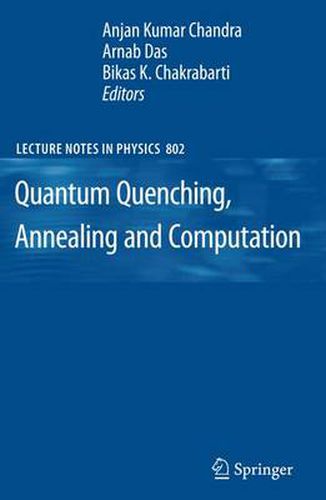Readings Newsletter
Become a Readings Member to make your shopping experience even easier.
Sign in or sign up for free!
You’re not far away from qualifying for FREE standard shipping within Australia
You’ve qualified for FREE standard shipping within Australia
The cart is loading…






This title is printed to order. This book may have been self-published. If so, we cannot guarantee the quality of the content. In the main most books will have gone through the editing process however some may not. We therefore suggest that you be aware of this before ordering this book. If in doubt check either the author or publisher’s details as we are unable to accept any returns unless they are faulty. Please contact us if you have any questions.
The process of realizing the ground state of some typical (frustrated) quantum many-body systems, starting from the ‘disordered’ or excited states, can be formally mapped to the search of solutions for computationally hard problems. The dynamics through the critical point, in between, are therefore extremely crucial. In the context of such computational optimization problems, the dynamics (of rapid quenching or slow annealing), while tuning the appropriate elds or uctuations, in particular while crossing the quantum critical point, are extremely intriguing and are being investigated these days intensively. Several successful methods and tricks are now well established. This volume gives a collection of introductory reviews on such developments written by well-known experts. It concentrates on quantum phase transitions and their dynamics as the transition or critical points are crossed. Both the quenching and annealing dynamics are extensively covered. We hope these timely reviews will inspire the young researchers to join and c- tribute to this fast-growing, intellectually challenging, as well as technologically demanding eld. We are extremely thankful to the contributors for their intensive work and pleasant cooperations. We are also very much indebted to Kausik Das for his help in compiling this book. Finally, we express our gratitude to Johannes Zittartz, Series Editor, LNP, and Christian Caron of physics editorial department of Springer for their encouragement and support.
$9.00 standard shipping within Australia
FREE standard shipping within Australia for orders over $100.00
Express & International shipping calculated at checkout
This title is printed to order. This book may have been self-published. If so, we cannot guarantee the quality of the content. In the main most books will have gone through the editing process however some may not. We therefore suggest that you be aware of this before ordering this book. If in doubt check either the author or publisher’s details as we are unable to accept any returns unless they are faulty. Please contact us if you have any questions.
The process of realizing the ground state of some typical (frustrated) quantum many-body systems, starting from the ‘disordered’ or excited states, can be formally mapped to the search of solutions for computationally hard problems. The dynamics through the critical point, in between, are therefore extremely crucial. In the context of such computational optimization problems, the dynamics (of rapid quenching or slow annealing), while tuning the appropriate elds or uctuations, in particular while crossing the quantum critical point, are extremely intriguing and are being investigated these days intensively. Several successful methods and tricks are now well established. This volume gives a collection of introductory reviews on such developments written by well-known experts. It concentrates on quantum phase transitions and their dynamics as the transition or critical points are crossed. Both the quenching and annealing dynamics are extensively covered. We hope these timely reviews will inspire the young researchers to join and c- tribute to this fast-growing, intellectually challenging, as well as technologically demanding eld. We are extremely thankful to the contributors for their intensive work and pleasant cooperations. We are also very much indebted to Kausik Das for his help in compiling this book. Finally, we express our gratitude to Johannes Zittartz, Series Editor, LNP, and Christian Caron of physics editorial department of Springer for their encouragement and support.